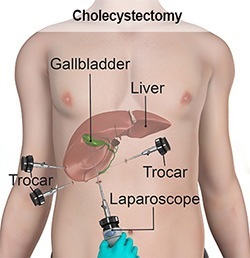The Treatment
Surgery

Gallbladder surgery is considered the standard of care for gallbladder disease treatment. Cholecystectomy surgery involves the removal of the gallbladder and is usually performed through laparoscopy, a minimally invasive option as compared to open abdominal surgery which requires a long incision. In cases where gallstones are present inside the bile ducts, endoscopic retrograde cholangiopancreatography (ERCP) technique can be used to remove these stones.
Procedure
Laparoscopic Cholecystectomy
Gallbladder surgery can be performed through a minimally invasive approach where your surgeon makes several small incisions in your abdomen. Through one of the incisions a laparoscope, a small fibre-optic tube with a tiny camera, is inserted. Through this approach, your surgeon will be able to view the surgery on a large screen. Cholangiography (X-ray of the bile duct) is performed to view the bile duct for any abnormalities. Special surgical instruments are inserted through the other incisions to remove the gallbladder. If your surgeon finds stones in the bile duct, they can also be removed.
If tests show the gallbladder has severe inflammation, infection or scarring from other operations, the surgeon may perform open surgery to remove the gallbladder. In some cases, open surgery is planned; however, sometimes these problems are discovered during the laparoscopic procedure and the surgeon must make a larger incision in order to convert to open surgery.
Endoscopic retrograde cholangiopancreatography (ERCP)
Endoscopic retrograde cholangiopancreatography (ERCP) is a procedure performed to remove gallstones blocking the bile ducts. The ERCP technique involves swallowing a long, flexible tube with a light source and camera called an endoscope, which helps your surgeon view the operating site on a monitor. The endoscope reaches the small intestine through the stomach and the affected duct is located by releasing a special dye. Your endoscopist cuts the affected duct with tiny instruments passed through the endoscope, and captures the gallstones in a mesh basket, which is then removed along with the endoscope.
Post–operative information
Following the procedure you will generally be discharged the next day if you have undergone a laparoscopic procedure, or within 2 to 3 days in the case of an open procedure. Inform your doctor immediately if you experience high fever, chills, severe pain, stomach cramps, vomiting, yellowish skin, increased drainage from the site of incision and no bowel movements for three days.
Benefits of this approach
Laparoscopic surgery requires minimal recovery time, shorter hospital stay, and you will experience less pain and discomfort after surgery, unlike traditional open surgery, which requires a longer hospital stay, recovery time and longer time to operate, and involves a larger scar.
Preparation
You may be instructed not to eat or drink anything at least six hours before the procedure in order to keep your stomach empty. Your surgeon will review your daily medications, and may suggest those that you can take with a sip of water. You will be instructed on the medications that you need to avoid.
Outcome
Laparoscopic cholecystectomy is a safe procedure that provides relief to symptoms of gallbladder disease. However, as with any procedure, cholecystectomy may involve certain risks and complications such as bleeding, blood clots, wound infection, or injury to the bile duct, intestine and blood vessels.
Post-op stages of recovery and care plan
After the procedure you will be given specific instructions with regard to your diet. You are instructed to eat high fibre foods and drink 8 to 10 glasses of water per day to avoid problems related with bowel movements. To relieve pain, you will be given pain relieving medications after surgery.
Care should be taken while dealing with your wound. Your dressing is usually waterproof and this will allow you to shower. Generally dissolving stitches are used and so do not need to be removed. Wearing tight fitting clothes is not recommended as it may rub against your incisions and interfere with the healing process. After about 4 to 6 weeks, your scars will become soft and gradually fade.
Down-time - lifestyle or off work duration
You can gradually resume your daily activities after the surgery. This normally takes around 2 weeks. To reduce the risks of blood clots you are encouraged to start walking as early as possible. You can return to work after 1-2 weeks after surgery. However, if your work requires lifting heavy objects, you can resume these activities only after 4 to 6 weeks.
Costs
Any costs involved will be discussed with you prior to your surgery.
Research
Extensive research is being done to find better treatment options for gallbladder disease. Some of the recent studies are listed below:
- Grading operative findings at laparoscopic cholecystectomy- a new scoring system World J Emerg Surg. 2015; 10: 14 doi:10.1186/s13017-015-0005-x; published online 8 March 2015.1






